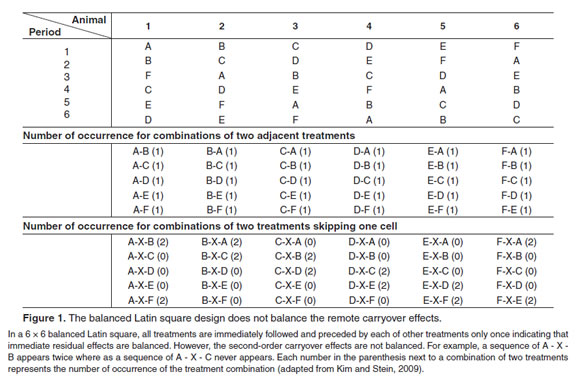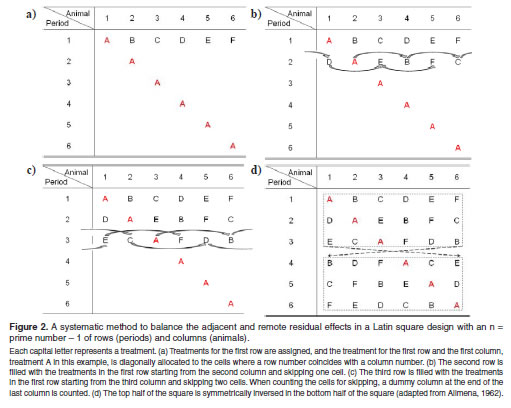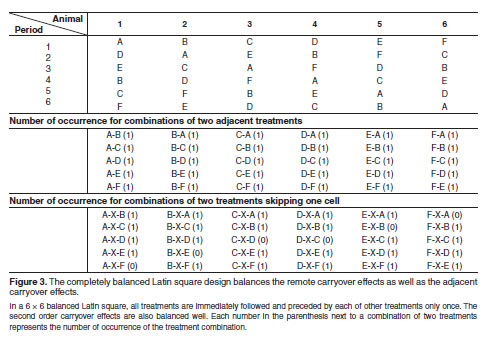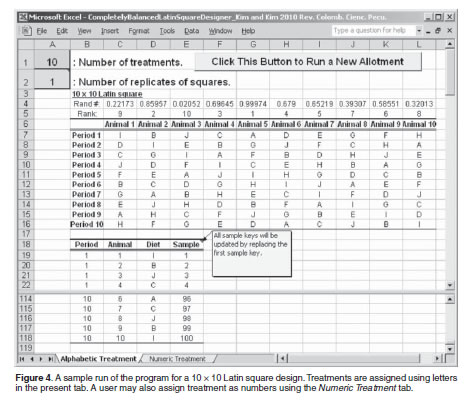Services on Demand
Journal
Article
Indicators
-
 Cited by SciELO
Cited by SciELO -
 Access statistics
Access statistics
Related links
-
 Cited by Google
Cited by Google -
 Similars in
SciELO
Similars in
SciELO -
 Similars in Google
Similars in Google
Share
Revista Colombiana de Ciencias Pecuarias
Print version ISSN 0120-0690On-line version ISSN 2256-2958
Rev Colom Cienc Pecua vol.23 no.3 Medellín July/Sept. 2010
Artículos originales
A program for making completely balanced Latin Square designs employing a systemic method¤
Programa para lograr un balance total en los diseños estadísticos tipo Cuadrado Latino, empleando un método sistémico
Programa para lograr um balanceamento total nos delineamentos estadísticos tipo Quadrado Latino, usando um método sistêmico
Beob G Kim1*, PhD; Taemin Kim2*†, PhD.
1 Department of Animal Science and Environment, Konkuk University, Seoul 143-701, Korea. 2 Intelligent Robotics Group, NASA Ames Research Center, MS 269-3, Moffett Field, CA 94035, USA.
(Recibido: 25 mayo, 2010; aceptado: 8 junio, 2010)
Summary
Animal scientists employ Latin square designs to reduce the required number of animals for detecting statistical differences in animal experiments. Randomization procedures do not balance residual effects that possibly exist in Latin square experiments. A spreadsheet-based program is available for making Latin square designs balanced for the first-order residual effects. The balance of remote residual effects may also be very important to consider when a relatively long latent period exists after a treatment. We have developed a spreadsheet-based program, the Completely Balanced Latin Square Designer (CBLSD), to facilitate the generation of Latin squares (n = prime number – 1) balanced for immediate and remote carryover effects. The program allows a user to choose the number of treatments that is equal to the number of animals and periods in a square. A user may also input the number of squares. Then, the CBLSD instantly generates a Latin square balanced for the multi-order as well as first-order carryover effects. Also provided is a schedule table for an experiment sorted by period and animal. The CBLSD enables animal experimenters to quickly and accurately make Latin squares balanced for the immediate and remote carryover effects. The program is freely available upon request.
Key words: animal experiment, Latin square design, remote carryover effect.
Resumen
El diseño estadístico llamado Cuadrado Latino se utiliza en experimentación con animales con el fin de reducir el número de animales requerido para detectar diferencias significativas entre tratamientos. Los procedimientos comunes de aleatorizacion no balancean los efectos residuales que podrían existir al usar el Cuadrado Latino. Ya se encuentra disponible un programa, basado en una hoja de cálculo, que sirve para balancear Cuadrados Latinos en sus efectos residuales de primer orden. Sin embargo, también se debería realizar el balanceo de los efectos residuales remotos, particularmente cuando existe un periodo latente relativamente prolongado después de un tratamiento. Hemos desarrollado un programa denominado Completely Balanced Latin Square Designer (CBLSD), basado en una hoja de cálculo, para facilitar la generación de Cuadrados Latinos (n = numero primo -1) balanceados para los efectos acumulativos (persistentes) tanto inmediatos como remotos. El programa permite al usuario escoger el número de tratamientos equivalente al número de animales y periodos en un cuadrado. El usuario puede también asignar el numero de cuadrados. El CBLSD instantáneamente genera un Cuadrado Latino balanceado tanto para los efectos persistentes de primer orden, como para los multi-orden. Adicionalmente, se provee una tabla para programar los tratamientos en un experimento organizado por periodo y por animal. El CBLSD permite balancear Cuadrados Latinos rápidamente y con precisión. El programa está disponible de manera gratuita para todos los interesados, mediante solicitud vía email a los autores.
Palabras clave: diseño tipo cuadrado latino, efecto acumulativo remoto, experimentos con animales.
Resumo
O delineamento estadístico chamado Quadrado Latino é utilizado na experimentação com animais com o propósito de reduzir o número de animais requerido para detectar diferenças significativas entre tratamentos. Os procedimentos comuns de aleatorização não balanceiam os efeitos residuais que poderiam existir ao usar o quadrado latino. Tem-se disponível una planilha eletrônica que serve para balancear quadrados latinos em seus efeitos residuais de primeiro ordem, no entanto, dever-se-ia realizar um balanceio dos efeitos residuais remotos, particularmente quando existe um período latente relativamente prolongado depois de um tratamento. Foi desenvolvido um programa denominado Completely Balanced Latin Square Designer (CBLSD), baseado numa planilha eletrônica para facilitar a geração de quadrados latinos (n = número primo -1) balanceados para os efeitos acumulativos (persistentes), tanto imediatos como remotos. O programa permite ao usuário escolher o número de tratamentos equivalente ao número de animais e períodos em um quadrado. O usuário também pode indicar o número de quadrados. O CBLSD instantaneamente gera um quadrado Latino balanceado para os efeitos persistentes de primeiro ordem e para os multi-ordem. Adicionalmente, tem uma tabela para programar os tratamentos no experimento organizado por períodos e por animais. O CBLSD permite balancear quadrados Latinos rapidamente e com precisão.O programa está disponível de forma gratuita, mediante solicitude via email dos autores.
Palavras chave: delineamento tipo quadrado latino, efeito acumulativo remoto, experimentação animal.
Part of this work was done while Taemin Kim was at Korea Advanced Institute of Science and Technology, Daejeon 305-701, Korea.
¤ Para citar este artículo: Kim BG, Kim T. A program for making completely balanced Latin Square designs employing a systemic method. Rev Colomb Cienc Pecu 2010; 23:277-282.
* Autores para correspondencia: Beob G. Kim. Department of Animal Science and Environment, Konkuk University, Seoul 143-701, Korea. E-mail:bgkim@ konkuk.ac.kr; Taemin Kim. Intelligent Robotics Group, NASA Ames Research Center, MS 369-3, Moffett Field, CA 94035, USA. E-mail: taemin.kim@nasa.gov.
Introduction
In animal experiments, the Latin square design typically employs less number of animals for difference detection between treatments compared with other experimental designs. The Latin square design has been widely used in animal studies (Pardo et al., 2008; Kim et al., 2009).
Potential carryover effects in Latin square designs are generally not balanced by randomization by row, column, or both. A systemic method presented by Williams (1949) balances out fi rstorder carryover effects, and a program is available for making balanced Latin square designs (Kim and Stein, 2009). However, remote (second, third, fourth, etc.) carryover effects are still not balanced in this method. For example, treatment A is remotely (skipping one period) followed by treatment B twice whereas treatment A is never remotely (skipping one period) followed by treatment C (Figure 1).
The balance of remote carryover effects is very important particularly when a relatively long latent period exists after a treatment such as infection (Nath et al., 2008). A systemic method is available for balancing the remote as well as the adjacent residual effects (Alimena, 1962). Although this systemic method is not extremely complicated, it is time-consuming to build a large-size Latin square design and is an error-prone procedure. Thus, the objectives are to illustrate the systemic method as it can be understood intuitively and to develop the Completely Balanced Latin Square Designer (CBLSD) to facilitate the generation of Latin squares balanced for remote carryover effect.
A systemic method for completely balanced Latin square designs
The systemic method balances the remote residual effects when the number of treatments is a prime number – 1 such as 2, 4, 6, 10, 12, 16, 18, 22, 28, 30, 36, etc (Alimena, 1962). An example for generating a completely balanced 6 × 6 Latin square design using this method is presented in Figure 2. In this example, each capital letter represents a treatment. Firstly, treatments for the first row are assigned and can be randomized, and the treatment for the first period (row) and the first animal (column), treatment A, is diagonally allocated to the cells where a row number coincides with a column number (Figure 2a). The second period is filled with the treatments assigned in the first period starting from the second animal and skipping one animal (Figure 2b). The third period is filled with the treatments assigned in the fi rst period starting from the third animal and skipping two animals (Figure 2c). When counting the animals for skipping, a dummy animal (column) at the end of the last animal is counted. The top three periods of the square is symmetrically inversed in the bottom three periods of the square (Figure 2d).
The general procedure to generate a completely balanced Latin square of size n can be described in a simple formula. Let i, j, and k be the indices of period, animal, and treatment, respectively. Suppose that the kth treatment is assigned to the jth animal in the ith period, i.e.,
Treatment (i, j) = k
Then the animal which takes the kth treatment in the ith period is determined as follows:
j = (i × k) mod (n + 1)
where mod is the modulo operation. Given two natural numbers, a (the dividend) and m (the divisor), a mod m is the remainder, on division of a by m. This formula refl;ects the exact procedure described above and simplifies the algorithm.
If treatments are assigned using the systemic method illustrated above, the remote carryover effects are balanced in addition to the immediate ones (Figure 3). In this example for a 6 × 6 balanced Latin square design, all treatments are immediately preceded and followed by all other treatments exactly once. In addition, all treatments are remotely preceded and followed by all other treatments at most once. It is inevitable to have the never-occurring remote combinations because the number of remote carryover combinations is less than the number of all possible combination of two treatments.
Program description
Using the method described above, a spreadsheet-based program is developed to facilitate the generation of Latin squares balanced for remote and immediate carryover effects (Figure 4). The CBLSD has been coded using Visual Basic for Application as an Excel 2003 add-in. The program file runs with no special installation, but a user needs to enable macros to fully use the functions in the CBLSD.
The user chooses the number of treatment (prime number – 1; i.e., 2, 4, 6, 10, 12, 16, 18, 22, 28, 30, 36, etc.) that coincides with the number of periods and animals and inputs the number of replicates of squares (Figure 4). The user then clicks the running button to instantly run an allotment. The treatments for the first period are randomly assigned to the animals based on the random numbers generated, and the treatments for the rest periods are systemically allocated as described in Figure 2. Additionally, an experimental schedule is generated. This schedule is sorted by periods and animals, and respective sample numbers are assigned. The sample numbers are consecutive and will be updated by changing the first one. A user may also use the Numeric Treatment tab to assign treatments as numbers.
Although the CBLSD balances the remote and adjacent carryover effects, this program can be used when the number of treatments is prime number – 1. In other cases, the balanced Latin square designer (Kim and Stein, 2009) need to be used to generate Latin squares balanced for only immediate carryover effects.
In conclusion, the spreadsheet-based program introduced in the present paper allows animal researchers to rapidly and accurately generate Latin squares balanced for the remote carryover effects as well as immediate carryover effects. The program is freely available upon request to one of the corresponding authors.
Acknowledgement
The present work was supported by the faculty research fund of Konkuk University in 2010.
References
1. Alimena BS. A method of determining unbiased distribution in the Latin square. Psychometrica 1962; 27:315-317. [ Links ]
2. Kim BG, Petersen GI, Hinson RB, Allee GL, Stein HH. Amino acid digestibility and energy concentration in a novel source of high-protein distillers dried grains and their effects on growth performance of pigs. J Anim Sci 2009; 87:4013-4021. [ Links ]
3. Kim BG, Stein HH. A spreadsheet program for making a balanced Latin Square design. Rev Colomb Cienc Pecu 2009; 22:591-596. [ Links ]
4. Nath M, Wolliams JA, Bishop SC. Assessment of the dynamics of microparasite infections in genetically homogeneous and heterogeneous populations using a stochastic epidemic model. J Anim Sci 2008; 86:1747-1757. [ Links ]
5. Pardo O, Carulla JE, Hess HD. Effect of protein and energy relationship on the levels of ammonium rumen and blood urea nitrogen and milk, in dual purpose cows at the llanero foothills, Colombia. Rev Colomb Cienc Pecu 2008; 21:387-397. [ Links ]
6. Williams EJ. Experimental designs balanced for the estimation of residual effects of treatments. Aust J Sci Res 1949; A2:149-168. [ Links ]


















